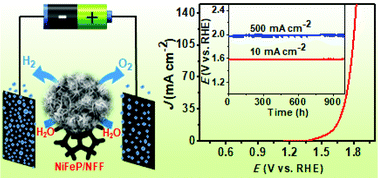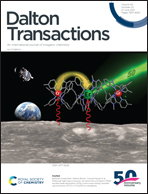One-step synthesis of amorphous nickel iron phosphide hierarchical nanostructures for water electrolysis with superb stability at high current density†
Abstract
The development of noble-metal-free high-performance bifunctional catalysts for both the oxygen evolution reaction (OER) and hydrogen evolution reaction (HER) is essential but challenging for hydrogen production from water electrolysis. Herein, amorphous bimetallic nickel–iron phosphide hierarchical nanostructures enrooted on nickel–iron alloy foam (NiFeP/NFF) are facilely fabricated via direct phosphidation of NFF at low temperature and developed as an efficient self-supporting bifunctional electrocatalyst to catalyze both the OER and HER with high activity, fast kinetics and excellent stability. Moreover, an alkaline water electrolyzer simultaneously utilizing NiFeP/NFF as the cathode and anode only needs a cell voltage of 1.58 V to afford a current density of 10 mA cm−2, overpassing most of the reported bifunctional electrocatalysts and comparable to noble metal-based ones. Impressively, the NiFeP/NFF-based symmetric electrolyzer can work well without appreciable performance degradation at a high current density of 500 mA cm−2 for over 1000 h for continuous hydrogen production with 100% faradaic efficiency, showing superb durability and great promise for industrial application.



 Please wait while we load your content...
Please wait while we load your content...